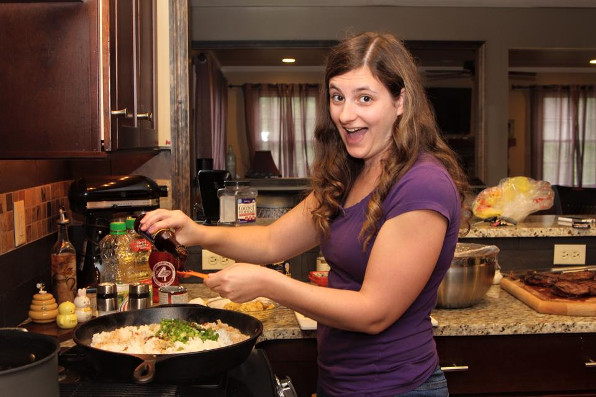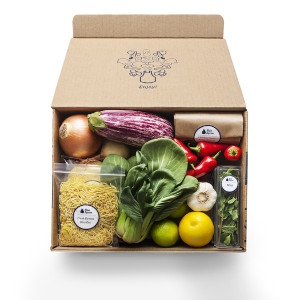Recent market research figures show that restaurant dining has taken a serious hit over the past 18 years. Even Fast Food legends such as McDonald’s are concerned as new options for home-dining continue to own the headlines, and food prices and restaurant operating costs continue to rise…
 If you feel this enthusiastic about home cooking, you’re on track
If you feel this enthusiastic about home cooking, you’re on track
not only to eating cheaper but eating better…
Have you tried those home-delivered Meal Kits, brought home supper from the Prepared Foods counter at the supermarket, or – perhaps as a last resort – returned to home cooking at least part of the time to make your food budget go further? You’re not alone.
A new survey by research group NPD shows that dining out visits per person per person in the U.S. have dropped from a 2000 high of over 215 to a mid-2018 low of just 185. Multiply the difference by a conservative U.S. population count of 300 million and you get a staggering 900 million fewer dining-out meals. Then multiply that by a conservative tab of (US)$10 per meal, and you get an almost unbelievable (US)$9 billion erosion of the market. No wonder the resto sector is worried, especially the fast Food Guys who are seem to have more limited specials on their menus than permanent items, just trying to keep potential customers interested in their option.
The resto sector challenge…
In a word restos have faced major labour and food cost increases over the past ten years. If that wasn’t bad enough, the dining-out industry has been over-crowded in all niches for at least that same period of time, causing desperate attempts by the players to gain and hold diners’ attention.
At the same time, inflation has made restaurant meals almost 10 percent more expensive than home-prepared meals. Cost of dining out versus dining in were about on a par in 2000.
Not to mention competition from foodservice sectors that did not exist in 2000: supermarket prepared-foods and prepared-meals bars, home-delivered meal kits and food delivery services.
Supermarkets…
Supermarket ‘Deli’ sections have exploded from small displays of specialty and international foods in 2000 to large spaces devoted not only to prep and sale of ready-to-eat foods but also to seating areas where shoppers can take a break and fuel-up. It’s cheaper to buy, say, a pre-cooked Rotisserie Chicken and some prepared Salads than it would be to eat the same thing at a sit-down restaurant, or to cho0w down on Fast Food. The savings multiply with the number of mouths you’re feeding.
Meal Kits…
There are literally dozens of Meal Kit purveyors who put together boxes of ingredients, pre-measured and (in some cases) pre-cut, along with instructions on how to cook them. One major benefit of these Kits is hat they are delivered to your door: no trip to the supermarket, nagging leftovers or problematic ingredient substitutions involved. And the folks who sell them want you to look upon their products as offering a hub around which the whole family can get together to both prepare and consume the meals.
A trend back to home cooking…
Supermarket shoppers quizzed on their buying baits have revealed a return – though grudging, in some cases – to home cooking as a response to rising food and restaurant meal prices. Family shoppers, in p[articular, say their food budgets just don’t go as far as they used to and cutting out or reducing dining-out meals is their main means of making ends meet. Along with this trend comes a danger of shoppers making poorer food choices – opting for cheaper foods of which they can afford greater volumes, rather than making more expensive, more nutritious decisions. On the other hand, home cooks who are aware of the benefits of a varied, balanced diet are finding they can feed their families better, more nutritious meals while still spending less than it would cost to dine out.
What’s a threatened restaurant to do?
Fast Food chains have begun to merge and fold under the pressure of sales slumps and hotter competition. I’ve said in the past that I foresee a serious shakeout in the Fast Food sector over the 2020s. I’ve recently remarked that the shakeout may already have started, with mergers such as Arby’s acquisition of Buffalo Wild Wings, and the massive restructuring and downsizing of menus by especially embattled chains such as Chipotle’s. Not to mention the much-publicised ‘return to a focus on our core identity’ programs proclaimed by chains like Chili’s over the past year or so.
Will that be enough to save them all from disaster? No, I don’t think so.
In fact, I think we’;ll see many more mergers and closings which will leave only the healthiest, most broadly-appealing brands standing by 2030. Maybe even as early as 2025.
Stay tuned…
~ Maggie J.

